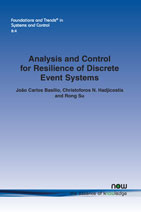Analysis and Control for Resilience of Discrete Event Systems: Fault Diagnosis, Opacity and Cyber Security
By João Carlos Basilio, Universidade Federal do Rio de Janeiro, Brazil, basilio@dee.ufrj.br | Christoforos N. Hadjicostis, University of Cyprus, Cyprus, chadjic@ucy.ac.cy | Rong Su, Nanyang Technological University, Singapore, rsu@ntu.edu.sg
Abstract
System resilience captures the ability of the system to withstand a major disruption within acceptable performance degradation and to recover within an acceptable time frame. In this monograph we consider two possible sources of major disruptions, i.e., component faults and cyber intrusions. A component fault is an indigenous activity that renders unavailability or inaccessibility of certain functions within a component, either permanently or temporarily. It typically generates safety and performance concerns. Cyber intrusion on the other hand is an exogenous activity that tampers privacy, confidentiality, availability, or integrity of the system. These two sources are not always independent from each other. For example, a cyber intrusion may trigger a component fault, whereas a component fault may open a door for cyber intrusion, e.g., by keeping it undetected. For cyber intrusion, we will focus on opacity, which describes the system’s ability to hide certain secrets from an external observer (or eavesdropper), and sensor and actuator attacks that exploit the system’s existing controller to generate undesirable behaviours.
In this monograph, we provide a detailed account of most recent research outcomes on fault diagnosis, opacity analysis and enhancement, and cyber security analysis and enforcement, within suitable discrete event system modelling frameworks. In each case, we describe basic problem statements and key concepts, and then point out the key challenges in each research area. After that, we present a thorough review of state-of-the-art techniques, and discuss their advantages and disadvantages. Finally, we highlight key research directions for further exploration.
Analysis and Control for Resilience of Discrete Event Systems: Fault Diagnosis, Opacity and Cyber Security
As modern systems become larger and the impact of a failure can be wide-ranging in some cases causing havoc to everyday life system reliance, the ability of a system to withstand major disruption and to recover within an acceptable time frame, becomes increasingly important. While systems failures can have many causes, component faults and cyber intrusions are two common such causes which can occur separately or one type can cause another failure of the other type.
In this monograph, the authors describe in detail the research on fault diagnosis, opacity analysis and enhancement, and cyber security analysis and enforcement, within suitable discrete event system modelling frameworks. In each case, they describe basic problem statements and key concepts, and then point out the key challenges in each research area. Finally the authors present a thorough review of state-of-the-art techniques, and discuss their advantages and disadvantages.
This monograph is a thorough overview of the cutting edge of research on resilient systems. It will be starting point for the readers own research into improving the reliability and fault-tolerance of modern-day engineering and computer systems.
